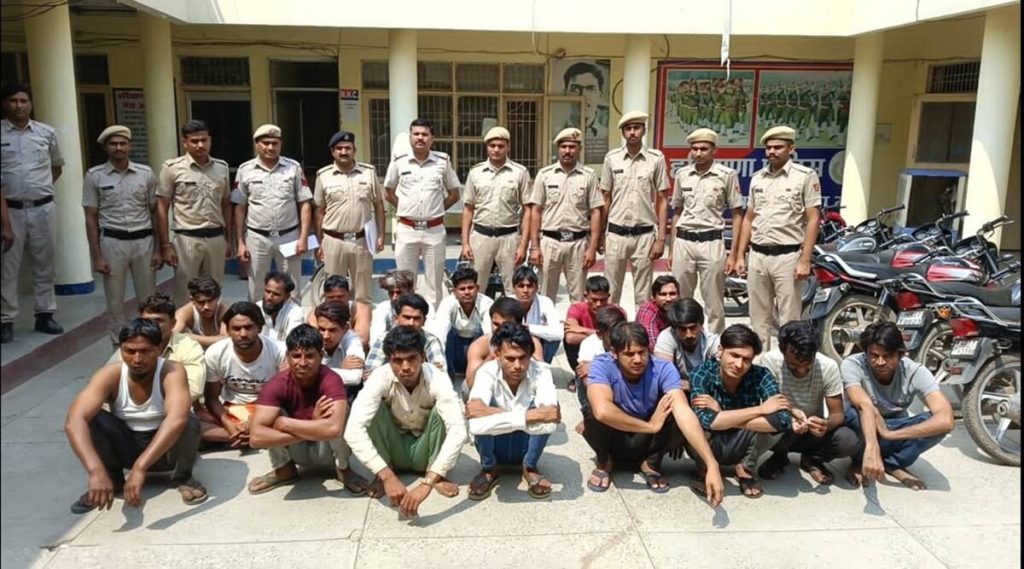
Nuh district of Haryana has eclipsed the infamous Jamtara district of Jharkhand, touted as the cybercrime capital of the country, if the recent police findings and crackdowns in the state’s district bordering Uttar Pradesh and Rajasthan are an indication. A report by Rajesh Moudgil
Just about a fortnight ago, Haryana police launched a crackdown in a bid to check a deluge of cybercrimes by blocking over 20,500 mobile numbers issued on fake and forged documents and flagging on its portal, over 34,000 other mobile numbers involved in cyber fraud operating from across the state including 40 hotspot villages of the state’s Nuh district which borders Delhi, Uttar Pradesh (UP) and Rajasthan.
According to the spokesperson of the Haryana police’s nodal agency, out of the total identified mobile numbers issued on fake ID, maximum 12,822 mobile numbers had been issued from Andhra Pradesh, 4,365 from West Bengal, 4,338 from Delhi, 2,322 from Assam, 2,261 from other North East states and 2,490 from Haryana; all these numbers were operating from different areas of Haryana and the same had been intimated to the Department of Telecom to block them.
The agency spokesperson said that about 14,000 more mobile numbers involved in cyber fraud would also be blocked soon through the Department of Telecom, Government of India. The spokesperson says at present, Haryana is at the top position in blocking mobile numbers used in cyber fraud.
This step had a background. Last month only, over 100 teams involving 5,000 police personnel of the state police had raided 14 cybercrime hotspots villages in Nuh district. Claiming that the police had apprehended 125 hackers and cyber offenders after carrying out simultaneous raids that progressed throughout the night in several villages of Nuh, the spokesperson held that that the highest number of 31 cyber offenders were nabbed from Nai village, followed by 25 from Luhinga Kalan village, 20 each from Jaimat and Jakhopur, 17 each from Khedla and Tirwara, and 11 from Aminabad.
A criminal carrying a reward of Rs 10,000 was also nabbed during these raids, the police had said, adding that a total of 66 smartphones, 65 fake SIMs, 166 Aadhaar cards, 3 laptops, 128 ATM cards of different banks, 2 ATM swipe machines, 1 AEPS machine, 6 scanners and 5 PAN cards were also recovered from the criminals and hackers, besides 7 country-made pistols, 2 cartridges, 2 cars, 4 tractor-trolleys and 22 motorcycles. The raids were conducted by the police targeting 69 accused involved in cyber and other criminal cases.
According to reports, the Nuh police claimed to have solved a large number of cybercrimes involving frauds worth over Rs 100 crore by registering about 1,300 cases against suspects from Nuh in coordination with the Indian Cybercrime Coordination Centre of the Union Home Ministry and seeking information about fake bank accounts and SIMs etc to trace the suspects.
The Haryana State Crime Branch chief and Additional Director General of Police (ADGP), O P Singh, says the state crime branch, as the state nodal agency for cybercrime, has a team of 40 highly skilled cyber police personnel deployed at Helpline 1930 to promptly register reported incidents and collect relevant data. Hamid Akhtar, an IPS officer currently serving as DIG in the State Crime Branch, has been appointed as the nodal officer of this coordination centre.
Mewat region, the new epicentre
Meanwhile, according to available information, Jharkhand’s Jamtara district is now said to have been surpassed by the Mewat region – a region which is broader than the Nuh district (earlier known as Mewat) of Haryana – as regards the cybercrimes. The Mewat region – home to Meo Muslims – comprises Bharatpur and Alwar districts of Rajasthan and Mathura of Uttar Pradesh, besides Haryana’s Nuh district which shares borders with the two states.

According to media reports, Bharatpur tops the chart of cyber frauds followed by Mathura and Nuh, in order of their standing. Haryana’s Gurugram and Rajasthan’s Alwar districts are also among the top 10 hotspots from where the more than half of the cybercrimes are reported in the country, originate.
Media reports say that the official data which shows a sharp rise in the number of cybercrimes in the past three years also indicates that the most of the cybercrimes reported in the country originated from these spots from Mewat region and that, significantly enough, the victims and the perpetrators had often been in locations separated by hundreds of miles. In numbers, about 16% of the cybercrimes originated from Bharatpur, 14% from Mathura and 12% from Nuh. Even Jamtara district too reported 12% cybercrimes across the country during this period.
Simply put, while Mewat region has emerged as the new hub for the cybercrimes and cyber frauds, Jharkhand (for its Jamtara district) continues to be the single largest state from where about 26% of the country’s total cybercrimes originate. Jharkhand is followed by Haryana with 22% such cases and Rajasthan with 20.1%, according to reports.
Interestingly enough, such was the notoriety of the cyber frauds originating from Jamtara that it had inspired a Netflix series a few years ago!
Uninformed the sitting ducks
According to police, the cybercrimes – a side-effect of the tech revolution – are because of lack of information or education among a huge section of society who lack knowledge as to how to protect themselves; they are the sitting ducks for these fraudsters who simply talk to them into sharing their one-time-password (or OTP) number while offering them a variety of “schemes’’.
Espousing an advanced training and equipment for police personnel, the investigators also opine that the hotspots happen to be areas with a large population with hardly any job opportunities and factors that could lead many to break the law to make a fast buck with help of phone SIMS obtained on the basis of fake documents. Places like Nuh are another challenge for the investigators because of the jurisdiction factors as it is located in close proximity to UP, Delhi and Rajasthan towns and this factor hinders the cops’ chasing the scamsters red-handed or say, in real-time before their trail goes cold and they destroy the evidence!











